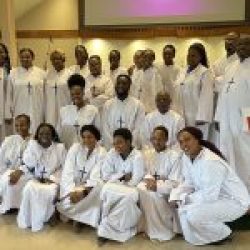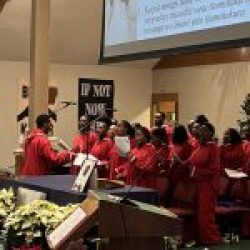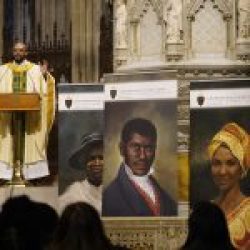ABOVE: Father Augustus Tolton in an undated photo. (OSV News photo/courtesy of Archdiocese of Chicago Archives and Records Center)
Content submitted courtesy of Toni Guidice
“As I look back on my life, I realize that every time I thought I was being rejected from something good, I was actually being redirected to something better.” – Father Augustus Tolton, candidate for sainthood
The All Saints Church Black Catholic Task Force will host a Convocation of Catholics of African Descent on April 12-14. The event will take place at All Saints Church, located at 1340 Lancaster Ave., in Syracuse. Bishop Douglas J. Lucia will open the convocation.
The goal of the event, where all are welcome, is to gather Catholics of African descent and friends to celebrate the presence, culture, legacy and future of Catholics of African descent in the Syracuse Diocese.
As part of the event on the morning of April 13, keynote speaker ValLimar Jansen will present a workshop on the six African Americans who are candidates for sainthood — devout souls who carried out great ministries despite experiencing the omnipresent pain of racial prejudice and discrimination within the church and society.
Profiles of the six candidates are below.
To register to attend the convocation, visit tinyurl.com/SyrBlackCatholic
(or https://forms.gle/W4mBFKFnGcpVEUA3A)
To contact All Saints Church call (315) 472-9934 ext. 4 (Hours M-Th 9am-2pm) or email parish@allsaintssyracuse.org
The six African American candidates for sainthood
Sister Thea Bowman was born in 1937 in Canton, Mississippi, and was named Bertha Elizabeth. Her father (Theon) was a physician and her mother (Mary Esther) was a teacher. Her grandparents had been slaves. Although the Bowman family was not Catholic, Thea attended Catholic schools and, at the age of 9, asked her parents if she could convert to Catholicism. She entered the Franciscan Sisters of Perpetual Adoration, who had taught her. Thea became the order’s first African-American sister. She chose the name “Sister Thea” after her father and to honor Mary, the Mother of Jesus. She became a teacher, earned her doctorate degree and taught college. She taught and worked to end racism. In 1984, Sister Thea was diagnosed with breast cancer. Despite her failing health, she continued her mission from a wheelchair. She died in 1990.
She summed up her life’s philosophy in this way: “I think the difference between me and some people is that I’m content to do my little bit. Some people think they have to do big things in order to make change. But if each one would light a candle, we would have tremendous light.”
Henriette Delille was born in New Orleans in 1812 to a wealthy Frenchman and to a free Creole Mother. Her great-great grandmother had been a slave. She had been trained in French literature, dancing, nursing and music so that she would be prepared to be the companion of a wealthy white man as the three generations of women in her family had been before. Henriette, however, although always Catholic, underwent a deeper conversion in her early 20s and became firmly committed to the sanctity of marriage. She was active in teaching black children, both free and slave, although it was not legal to teach slaves in Louisiana at the time. She wanted to be a sister, but because of her African heritage, the communities of European sisters would not accept her, and the laws of Louisiana would not permit communities with blacks and whites together. After much struggle and many encounters with racism, she founded the Sisters of the Holy Family who served as teachers, opened orphanages and opened a home for elderly Black women, some of whom had been slaves. It was the first nursing home sponsored by the Church in the United States. She died in 1862.
Julia Greeley was born a slave in Hannibal, Missouri, around 1835. She suffered horrific treatment during her enslavement. Her right eye was blinded when her slave master was beating her mother and the whip caught her in the eye. In 1865, she was freed by the U.S. government. She worked as a servant and moved to Denver with a family she served. There she became Catholic and joined Sacred Heart Parish of Denver. She was dedicated to the Sacred Heart and the poor, although she herself was very poor, earning $10-$12 a month cleaning and cooking. She became an active member of the Secular Franciscan Order in 1901. She walked the streets of Denver pulling a red wagon full of items she had begged for the poor or purchased from her meager earnings. She usually worked secretly and at night to avoid embarrassing the families she helped. Each month she walked to every firehouse in Denver to distribute Sacred Heart images and leaflets to city firefighters. She died unexpectedly on June 7, 1918, Feast of the Sacred Heart, and was mourned by thousands. She is called Denver’s Angel of Mercy.
Mother Mary Lange was born in Cuba around 1794 and was named Elizabeth Clarisse. Her parents were Haitians who had fled to Cuba during the revolution. Elizabeth came to the United States in 1813, living in Baltimore where there was a large Haitian settlement in the Fell’s Point area of the city. She saw firsthand the plight of the French-speaking Haitian children who had no free public school to attend. She and her friend, Marie Madeleine Balas, operated a school in Balas’s home from 1818 to 1828 to educate Haitian children. In 1828, with the support of Father James Hector Jourbert, a Sulpician priest, Mother Mary began formation of the Oblate Sisters of Providence and opened St. Francis Academy in 1828. (It is the oldest continuously active Catholic school for African Americans in the country). In 1829, the Oblates Sisters of Providence were officially formed and Mother Mary was elected Superior. In August, 1832, during the height of the cholera epidemic, city officials had asked for nuns to tend to the sick. The first order, a white one, was asked to send eight sisters; it sent four. When Father Joubert reluctantly approached the Oblate sisters and asked for volunteers, every sister stood up. He chose four. After Father Joubert died, the order lost its greatest benefactor and protector. There hadn’t been much enthusiasm in Baltimore for a convent of black religious women. But Father Joubert had bridged that gap. He was the order’s chaplain and celebrated Mass for the sisters daily. His replacement distanced himself from the sisters. Consequently, Mother Mary suffered greatly from poverty and racism. Mother Mary died in 1892 and is known for her deep faith and dependence on God’s providence. Her favorite saying was: “When prayers go up, blessings do come down.”
Augustus Tolton was born into slavery in 1854 in Brush Creek, Missouri. His parents, Martha Jane Chisley and Peter Paul Tolton were Catholic and had him baptized. When the Civil War broke out, Peter Tolton joined the Union army, but soon after died of dysentery. Martha escaped Missouri with her three children to Quincy, Illinois. At age 9, Augustus began working in a tobacco factory. Later he enrolled in St. Boniface School but left soon because of local reaction to a Black child being in the school. It was reported that even the school staff were harassed and threatened. The school’s Sisters of Notre Dame tutored Augustus privately. The parish priests were convinced that Augustus had a vocation and prepared him for college, but no seminary in the United States would accept him because of his race. He was sent to Rome and was intended to be ordained for ministry in Africa. When he was ordained in Rome, a Cardinal reportedly said to him, “America needs Negro priests. America has been called the most enlightened nation; we will see now whether it deserves the honor. If the United States has never seen a Black priest, it must see one now. Can you drink from this cup?” Tolton replied in Latin: “Posso.” “I can.” He became the first recognized Black priest in the United States. He labored zealously for the faith and faced much prejudice, even from fellow priests. Among those who supported his efforts was St. Katharine Drexel. He established the first black parish in Chicago where he served the African Americans in that city. He died of heat stroke in Chicago in 1887 at age 43.
Pierre Toussaint was born in Haiti in 1766 and was a slave on a sugar cane plantation owned by the Berard family. Pierre was taught to read and write and grew up in Catholicism. He came to New York City with his master when the revolution broke out in San Domingo (Haiti). He was apprenticed to a hairdresser at the age of 21 and became one of the most sought-after hairdressers by many of New York’s richest citizens. His trade allowed him access to the wealthy and influential and provided him with a lucrative livelihood. When Berard died, Pierre stayed on and took care of his widow until she remarried. In 1807, she granted Pierre his freedom just before her death. Pierre could have purchased his own freedom at any time, but, instead, he purchased freedom for others, including the woman he would marry and his sister. Pierre took in many homeless black youths into his home and educated them. He tended, at great risk to himself, victims of yellow fever who had been abandoned. He contributed financially to a number of charities, including orphanages for both black and white children. He even assisted penniless priests. He attended the 6 a.m. Mass at St. Peter’s Church every day and raised funds for the building of the original St. Patrick’s Cathedral (where he was once asked to leave because of his race. Someone else told the usher who he was). He died in 1853. He was so generous in his charity that some people today call him the founder of Catholic Charities in New York. He is the only lay person buried in the crypt of St. Patrick’s Cathedral in New York.
Source: Center for Catholic Education at Aquinas College






